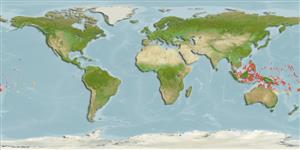Teleostei (teleosts) >
Atheriniformes (Silversides) >
Atherinidae (Silversides) > Atherinomorinae
Etymology: Hypoatherina: Greek, hypo = under + Greek, atherina, the Greek name for the eperlane; 1770 (Ref. 45335).
More on author: Herre.
Environment: milieu / climate zone / depth range / distribution range
Ecology
Marine; reef-associated; depth range 0 - 5 m (Ref. 57178). Tropical; 16°N - 23°S
Western Central Pacific: Sumatra to northern Cooks, north to the Philippines, Carolines and Marshall Islands, south to Fiji.
Size / Weight / Age
Maturity: Lm ? range ? - ? cm
Max length : 7.8 cm SL male/unsexed; (Ref. 54980)
Relatively common in both high island and atoll lagoons (Ref. 1602). They are not found in the rougher waters over reefs and are attracted to light at night in lagoons (Ref. 9760). Used as bait in the tuna fishery (Ref. 6822).
Life cycle and mating behavior
Maturity | Reproduction | Spawning | Eggs | Fecundity | Larvae
Oviparous, distinct pairing during breeding (Ref. 205).
Myers, R.F., 1991. Micronesian reef fishes. Second Ed. Coral Graphics, Barrigada, Guam. 298 p. (Ref. 1602)
IUCN Red List Status (Ref. 130435: Version 2024-1)
Threat to humans
Harmless
Human uses
Fisheries: of no interest; bait: usually
Tools
Special reports
Download XML
Internet sources
Estimates based on models
Preferred temperature (Ref.
123201): 26.9 - 29.3, mean 28.8 °C (based on 1498 cells).
Phylogenetic diversity index (Ref.
82804): PD
50 = 0.5001 [Uniqueness, from 0.5 = low to 2.0 = high].
Bayesian length-weight: a=0.00437 (0.00217 - 0.00879), b=3.15 (2.97 - 3.33), in cm total length, based on LWR estimates for this species & (Sub)family-body (Ref.
93245).
Trophic level (Ref.
69278): 3.3 ±0.4 se; based on size and trophs of closest relatives
Resilience (Ref.
120179): High, minimum population doubling time less than 15 months (Preliminary K or Fecundity.).
Fishing Vulnerability (Ref.
59153): Low vulnerability (10 of 100).
Nutrients (Ref.
124155): Calcium = 143 [75, 286] mg/100g; Iron = 0.761 [0.418, 1.395] mg/100g; Protein = 19.4 [17.1, 21.8] %; Omega3 = 0.129 [0.056, 0.336] g/100g; Selenium = 15.1 [6.5, 37.2] μg/100g; VitaminA = 228 [65, 714] μg/100g; Zinc = 2.1 [1.4, 3.1] mg/100g (wet weight);
